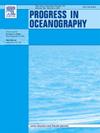在不同的房间里睡觉:在半封闭的深海湾中,一条小的上层鱼类和一条中上层鱼类之间的栖息地划分
IF 3.6
3区 地球科学
Q1 OCEANOGRAPHY
引用次数: 0
摘要
本文研究了半封闭的圣Matías湾(西南大西洋;南春40°47′S—42°13′S),主要集中在两个潮锋区(西北偏西北;SE:东南)。声学数据,胃内容物分析(猎物相对重要性;结合Schoener指数、CTD剖面(原位温度和盐度)、卫星叶绿素-a、浮游动物采样(200 μm mesh)和多模型推断来评估物种之间的竞争和/或资源分配。受海底温度和盐度的影响,凤尾鱼主要分布在近岸水域,而毛罗利乌斯主要分布在较深的水域,两者在100-150米共同出现,在西北偏多。两种昆虫的优势猎物均为桡足类南足虾(在东南地区消费较多)。凤尾鱼以十足目、桡足目(1 ~ 2 mm)和毛颌目(西北偏多)为食,毛颌目以东南方偏多)和同种卵为食。这些模式与浮游动物的可用性一致,由南部大陆架的水入侵形成。在这两个物种中都观察到饮食的变化,从中浮游动物到大型浮游动物,体型越来越大。没有发现食性重叠,提示生境划分和共存。这些结果强调了这两个物种在将浮游动物与独特的深海湾环境中的更高营养水平联系起来方面的生态作用,为测试这种远洋物种的共存和资源利用提供了机会。本文章由计算机程序翻译,如有差异,请以英文原文为准。
Sleeping in separate rooms: Habitat partitioning between a small epipelagic and a mesopelagic fish in a semi-enclosed deep Gulf
Spatial aggregation patterns, feeding ecology, and potential dietary overlap of a small epipelagic fish (Engraulis anchoita) and a mesopelagic fish (Maurolicus spp.) were examined in the semi-enclosed San Matías Gulf (Southwest Atlantic Ocean; 40°47′ S – 42°13′ S) during austral spring, focusing on two sectors of the tidal front (NW: northwest; SE: southeast). Acoustic data, stomach content analysis (prey relative importance; Schoener index), CTD profiles (in situ temperature and salinity), satellite chlorophyll-a, zooplankton sampling (200 μm mesh), and multi-model inference were combined to assess competition and/or resource partitioning between species. Engraulis anchoita occurred mostly nearshore, while Maurolicus spp. was associated with deeper waters, both co-occurring at 100–150 m and more abundant in NW, influenced by bottom temperature and salinity. The dominant prey for both species was the copepod Calanus australis (more consumed in SE). E. anchoita also consumed Decapoda larvae, Copepoda (1–2 mm), and Chaetognatha (preferred in NW), while Maurolicus spp. fed on Euphausiacea (more in SE) and conspecific eggs (in NW). These patterns aligned with zooplankton availability, shaped by southern shelf water intrusion. A dietary shift was observed in both species, from meso- to macrozooplankton with increasing size. No dietary overlap was detected, suggesting habitat partitioning and coexistence. These results underscore the ecological role of both species in linking zooplankton to higher trophic levels in a unique deep Gulf environment, providing an opportunity to test coexistence and resource use by this pelagic species.
求助全文
通过发布文献求助,成功后即可免费获取论文全文。
去求助
来源期刊

Progress in Oceanography
地学-海洋学
CiteScore
7.20
自引率
4.90%
发文量
138
审稿时长
3 months
期刊介绍:
Progress in Oceanography publishes the longer, more comprehensive papers that most oceanographers feel are necessary, on occasion, to do justice to their work. Contributions are generally either a review of an aspect of oceanography or a treatise on an expanding oceanographic subject. The articles cover the entire spectrum of disciplines within the science of oceanography. Occasionally volumes are devoted to collections of papers and conference proceedings of exceptional interest. Essential reading for all oceanographers.
 求助内容:
求助内容: 应助结果提醒方式:
应助结果提醒方式:


